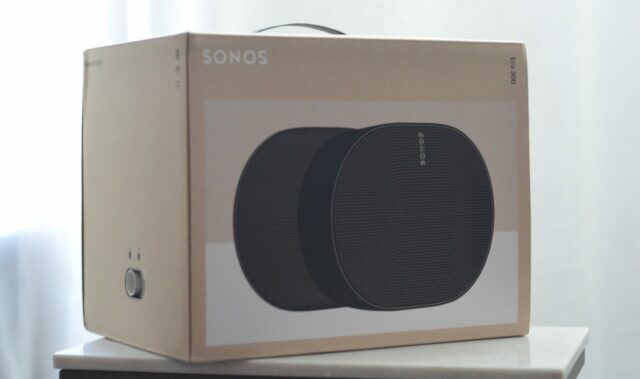
Sonos Era 300 Review

Sonos has been a leader in audio for over two decades and it continues to innovate and improve its products. This year, Sonos introduced the Era 300 speaker and it’s finally launching with support for spatial audio.
Spatial audio has been lauded for many years. With Dolby Atmos supported film, shows, and even music, the need to have hardware that offers spatial audio support is becoming increasingly important. For dedicated Sonos users, the Era 300 instantaneously becomes a speaker set worth looking into. Spatial audio provides a much more immersive listening experience. However, you need a good piece of audio tech to take full advantage of it. With a spatial audio-supported speaker, it’ll feel like sounds and music are coming in from every direction.
The Era 300 is in a roundabout way an upgrade and iterative step up from its Five speaker. It’s much like the Era 100, which is releasing simultaneously as a replacement of the Sonos One. Both new speakers are examining how Sonos can provide quality soundscapes to your living room and home.
However, the major difference between the two products is Sonos’ dedication to spatial audio support on the Era 300. The speaker also has a notable suite of smart home and voice assistant perks. Though, if you’re in the Google ecosystem, you’re kind of out of luck at the moment. All that is to say is that with premium-level features comes a premium price tag of $559. The Era 300 is available March 28th in Canada.
Out of the box
At first blush, it’s apparent that Sonos wants to make its Era 300 a statement piece in your living room and home. Much like the Five speaker, the new product is large in size, measuring 6.30 x 10.24 x 7.28 inches. It also weighs 9.85lbs. This means that, unlike other Sonos products, you’re likely not going to be travelling from room to room with it. Once you find an appropriate home for the Era 300, whether in the living room or otherwise, it’ll likely stay there.

The design of the Era 300 is similar to an hourglass. Perhaps one can read it as an ode to how timeless music and audio can be. In reality, Sonos designed the Era 300 to integrate angled drivers along the top, sides, and front. With a total of six drivers (one forward, two side, and one upward-firing), the speaker is able to direct sound in all directions. Sonos’ device also includes two woofers angled left and right for enhanced stereo playback. Plus, the Era 300 includes an upward-firing tweeter designed for Atmos support.

All of this is encased in one of Sonos’ most eco-friendly designs. The Era 300 is made up of 40 percent post consumer-recycled plastics. Paving a road towards a sustainable future is at the heart of the manufacturing process revolving around the new speaker. Even down to how the case and components are put together, Sonos is addressing.
The Era 300 features a reduced amount of adhesives, opting for screws. This not only improves sustainability efforts but the device’s lifecycle as repairs are easier to conduct. The packaging is also made up of 100 percent recyclable paper certified by the Forest Stewardship Council. From an energy consumption effort, the Era 300 uses 2W when idle and 8-9 Ws when playing at one-third volume, a drastic reduction from previous products.
Connectivity and use
Sonos is providing a wide range of connectivity support for the Era 300. Of course, you have your mainstays via the Sonos app. Once again, Sonos Voice Control can be used for playback. Users can play and pause songs, skip forward, etc all within the Sonos-powered ecosystem. If you’re already in the Sonos ecosystem, you can use the Sonos app to control playback or multi-room grouping and stereo-pairing if you desire. The app has always been a great solution and it continues to be one I often go out of my way to use because of how intuitive Sonos has made it.

Additionally, users can integrate the Era 300 into Amazon Alexa for voice control support. Plus, Apple AirPlay 2 is also being supported. However, if you’re a Google user and hope to see some Google Assistant support, you’re out of luck. Era 300 does not offer any support for Google, largely due to the ongoing legal dispute over patent infringement.
From a connectivity standpoint, the Era 300 features a new USB-C port for wired-in connections. If you’re aiming to use the speaker with a record player, you will require the company’s proprietary Line-In Adapter and Sonos Combo Adapter, both sold separately. Era 300 is the first flagship speaker to provide Bluetooth connectivity. Sonos claims that the speaker provides Bluetooth 5.0, which supports AAC and SBC. The speaker is also supporting Wi-Fi 6, which is exclusively the method to take advantage of spatial audio.

Sonos’ support of Bluetooth has been long overdue. It’s a great addition to the wide array of support. To kick through playlists on Spotify from my phone to the speaker is a breeze. Bluetooth is so common nowadays that it always seemed like a matter of when not if Sonos would ever offer it on one of their flagships.
The onboard UI also sees a nominal facelift. The Era 300 features subtle touch buttons to control play and pause functions as well as the ability to skip forward or back. There’s also a very sleek touch-receptive volume control bar. Plus, a voice control option is also available near the top. All in all, I really resonate with the changes Sonos has made to the control design. It’s now very subtle, nearly to the point where you may forget that the controls are even there at all.
A premium fit with premium audio
Sonos as a company wears its heart on its sleeve when it comes to its adoration of music. However, there’s been this emerging narrative where Sonos is showing as much love to the general entertainment space. The Era 300 sits somewhere in the middle where it can properly mingle with a record player in one instant and become a complimentary piece of a home entertainment set up alongside the Arc another.

I was elated the first time I streamed a beloved album on the Era 300 and began picking up subtle sound cues I never noticed thanks to a heightened sense of clarity. With spatial audio support, audio enveloped me as I listened to classic tracks and newer songs. In 2023, there’s a wide array of songs being remastered. Artists are also prioritizing Dolby Atmos and spatial audio mixing.
During my review period, my exposure to the Era 300’s spatial audio support was limited to Amazon Unlimited Music, which is available in Canada for $8.99 a month. However, as of the official launch, Sonos will support Apple Music, which offers spatial audio at $10.99 a month. Sonos isn’t supporting Tidal, any spatial audio provider but that may change down the line. The same may go for Spotify when its long-awaited HiFi plan launches.
There’s rare exceptions to how you should use the Era 300. Vocals come in very clearly. The bass is able to hit you like a truck when the speaker is bumped up. Whether listening to The Weeknd, Pink Floyd, or Imagine Dragons, there’s so much detail and clarity to garner from spatial audio on Era 300. However, that’s all to say that Sonos’ device can only complement a living space so much. There’s a variety of factors that can play into audio quality including room size, acoustics, etc. Thankfully, Trueplay, which is available to iOS users can assist.
A supplement for your entertainment
Sonos has the music side locked down as far as I’ve been concerned. However, in the past handful of years, Sonos has been leveraging its technology to better serve the entertainment space. Whether it’s rewatching The Office for the billionth time or Top Gun: Maverick, the Sonos Era 300 can be a complimentary addition to your home theatre space.

Let’s make one thing clear off the bat, the Era 300 isn’t going to be taking the spot of your central media soundbar or speaker system. While it boasts impressive audio tech, it simply wasn’t made nor designed to be that frontal speaker ahead of your TV. Instead, in a perfect scenario, you’d be able to pair an Era 300 with Sonos’ Arc, which supports Dolby Atmos. Ideally, you’d probably want to mount two Era 300 speakers as rear sound equipment, creating an elevated surround sound experience.
Unfortunately, I didn’t have access to a second Era 300 so my exposure to putting together the ultimate Sonos setup. However, I was able to test the directional sound that can be made from using an Era 300 as a rear speaker. As intended, footsteps of characters walking across the screen sounded like they were accurately coming from my left shoulder and into the centre of my living room. Voices, action set pieces, and even filmic scores all washed across my living room with the help of the Eta 300. If you’re intending to overhaul your home entertainment setup in the near future, Sonos is an obvious choice to look at.
Final thoughts
The Sonos Era 300 has securely and rightfully taken the place of the Five speaker as far as quality is concerned. This is undoubtedly a premium audio device that will help shape the next few years for the company. Having finally added support for spatial audio, Sonos is now in a place where it can provide that next-generation listening experience for users. Honing in on its advanced design philosophy and adapting it for spatial audio, users are in for a bonified treat regardless of whether it’s music or a movie they are tuning in for.
Unfortunately, the realities of business do damper the extent of third-party support. Not having access to Google Assistant may be a turn-off for some users. Additionally, spatial audio support is still so young and the speaker still has room to grow. Without support for Tidal or spatial audio available on Spotify, users may not be driven to adopt Apple Music or Amazon Unlimited Music just yet. Regardless, Sonos seemingly justifies its $559 price tag for the Era 300. Its quality of life changes and its impressive design demands attention.

